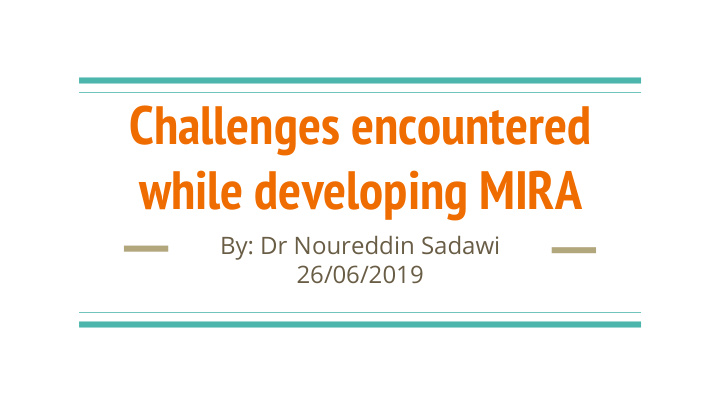



Challenges encountered while developing MIRA By: Dr Noureddin Sadawi 26/06/2019
Collaboration with ● Dr Alina Calin - MIRA Founder ● Dr Crina Grosan - Senior lecturer at Brunel University - London http://www.mirarehab.com/
Contents ● What is MIRA ● Example MIRA ExerGames ● Three Example Challenges face(d) MIRA Team ● Approaches to Tackle Challenge http://www.mirarehab.com/
What is MIRA? ● MIRA - (eHealth) telerehabilitation tool for physicians ● Developed in conjunction with physiotherapists, patient groups, academics and NHS providers ● Has been designed and developed based on clinical feedback and research ● Offers a comprehensive set of functionalities ● Runs on a Windows 7, 8 or 10 PC/laptop and requires a Microsoft Kinect sensor or similar http://www.mirarehab.com/
Example MIRA ExerGames Atlantis Izzy the Bee http://www.mirarehab.com/
Challenge 1: Adjustment to new types of sensor interaction (motion cameras) Motion cameras are not widely used; most of users have a day-to-day interaction experience with a touchscreen or mouse Difficulty to adapt to a movement “in air” which is remote (no direct contact with the sensor) Sensor responsiveness delays will activate reflexes of users repeating the movement (“try to drag the mouse again”) which impacts the interaction http://www.mirarehab.com/
Challenge 2: Identifying priority movement components Obtaining high accuracy in motion detection could be done combining multiple wearable sensors - it takes time to position them, discouraging users to adopt this When it comes to selecting the most important parameters to be analysed, we face a difficulty, as this is a a new approach for physiotherapists - they were used to having a look (or hands on) to detect movement correctness with ease We identify as main components: body posture (standing, sitting, limb angles) and movements characteristics (ROM, relative position, movement speed). But no physiotherapy standard is available to create a generalised model. AI can help! http://www.mirarehab.com/
Challenge 3: Addressing patients with limited mobility and abnormal movement patterns Providing feedback for movement correctness and advice for improving it is very important for home-based rehab. But when a movement was done incorrectly and detected as such, how do we make the difference between (a) a patient who can do it better and needs instructions on this, and (b) a patient who is limited in ROM or has an unusual body posture which can’t be overcome; for their case, the movement might be good as is and requires incentives of approval, but will be detected as incorrect on general standards; how do we handle this case? http://www.mirarehab.com/
Approaches to Resolve Issues ● Older people (>65) have found the system easy to use and interact with; learning curve is easy with proper training ● Methods to increase sensor accuracy (Kinect 3?) ● Try different approaches of motion analysis ML and work close to physiotherapists to create a standard ● Develop a patient- centric approach that defines the ‘norm’ of movement based on the patient’s actual ROM and particular body postures and movement patterns http://www.mirarehab.com/
Thank you
Recommend
More recommend